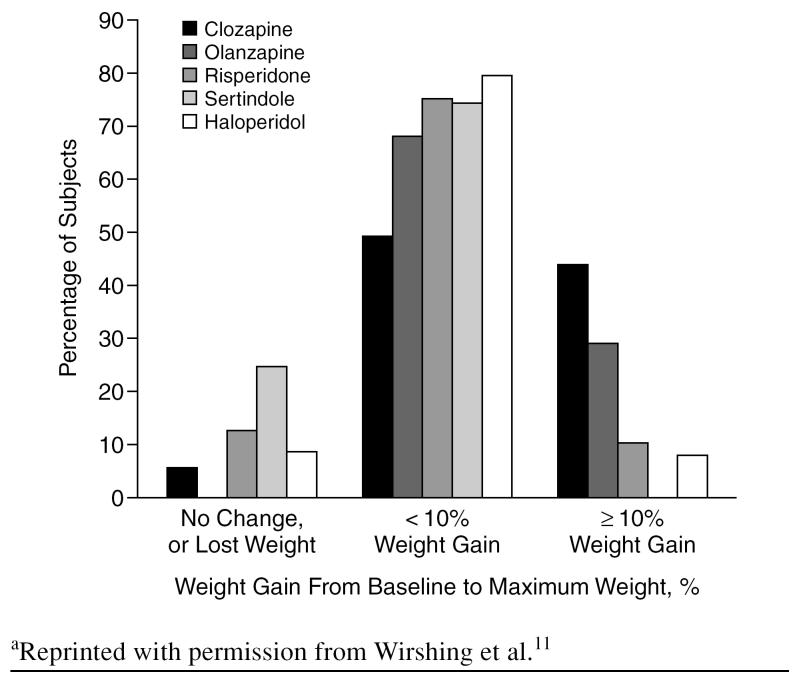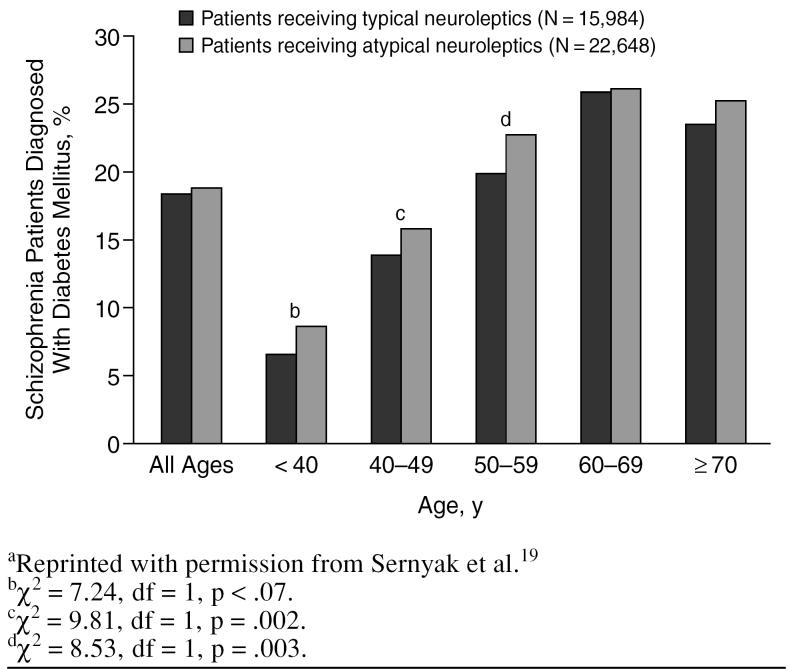Abstract
In the United States, the risk of type 2 diabetes is currently growing to epidemic proportions, with many physicians unaware that disorders such as schizophrenia and bipolar disorder naturally place patients at an increased risk for diabetes. Another serious concern for physicians is the development of metabolic syndrome, also known as syndrome X, in patients suffering from schizophrenia. Metabolic syndrome often encompasses medical conditions such as weight gain, hypertriglyceridemia, and increased insulin, glucose, and low-density lipoprotein cholesterol levels. Treatment with atypical antipsychotics may increase the risk of metabolic syndrome and diabetes, and physicians need to be proactive when treating patients with schizophrenia. Physicians should be aware that the treatment of schizophrenia involves the right balance for the patient in terms of adverse effects versus benefit, and failing to treat a patient's mental illness because of potential medical problems may place the patient at an increased risk for more serious problems.
In the United States, the risk of type 2 diabetes is growing to epidemic proportions. Today, physicians are more attuned to the risk of diabetes among patients, but many physicians are unaware that disorders such as schizophrenia and bipolar disorder are associated with increased risk of diabetes. The use of atypical antipsychotics may also place patients at risk for a complicated disorder known as metabolic syndrome. Physical changes such as weight gain may be an indication of metabolic side effects in patients treated with antipsychotics. Physicians treating patients with psychiatric disorders need to be attuned to physical changes that may be a sign of serious medical conditions such as diabetes or metabolic syndrome.
METABOLIC SYNDROME
The use of antipsychotics increases the risk not only of diabetes but also of metabolic syndrome, which is sometimes referred to as syndrome X. While a standard definition of metabolic syndrome does not exist, metabolic syndrome is generally thought to include weight gain and hypertriglyceridemia along with increased insulin, glucose, and low-density lipoprotein cholesterol levels (Table 1).1
Table 1.
Features of Metabolic Syndromea
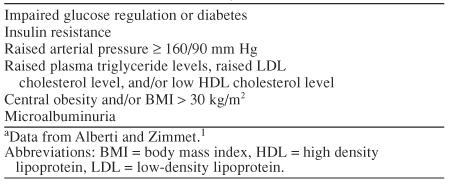
Although it is thought that a patient's genetic makeup and environment may directly contribute to metabolic syndrome,2 it is unknown why some patients will develop metabolic syndrome while others will not. Insulin resistance and obesity are considered to be integral elements in the development of metabolic syndrome,2 but accumulating evidence suggests that simply varying degrees of insulin resistance may be the common etiological factor for the individual components of metabolic syndrome.1
While metabolic syndrome itself is a serious health risk and medical complication, research3,4 suggests that metabolic syndrome may place patients at an increased risk for other serious medical diseases such as heart disease. In one study by Isomaa and colleagues,4 the risk of cardiovascular disease associated with metabolic syndrome was analyzed in 4483 subjects aged 35 to 70 years. The risk of coronary heart disease and stroke was found to be tripled among subjects with metabolic syndrome as compared with those who did not have metabolic syndrome (p < .001). Cardiovascular mortality was assessed in a median follow-up of 6.9 years in 3606 of the participants and was found to be increased among participants diagnosed with metabolic syndrome when compared with participants who were not diagnosed with metabolic syndrome (p < .001).
RISK FACTORS FOR METABOLIC SYNDROME
Abnormalities in glucose regulation were first reported in patients with schizophrenia and bipolar disorder prior to the introduction of antipsychotic medication, with early reports5,6 indicating a pattern of insulin resistance in untreated patients. However, treatment with antipsychotic medications is also associated with weight gain, impaired glucose metabolism, exacerbation of existing type 1 and type 2 diabetes, new onset of type 2 diabetes mellitus, and diabetic ketoacidosis.7,8 The onset of one or all of these side effects increases the probability of patients developing metabolic syndrome; patients displaying these side effects should be monitored carefully.
Weight Gain
Weight gain may be the most noticeable signal of metabolic syndrome and is usually the most distressing issue among patients. Physicians should view dramatic weight gain as a red flag for complicating medical issues. Even without the development of diabetes or metabolic syndrome, significant weight gain associated with antipsychotic treatment may compromise a patient's health by contributing to comorbid conditions such as hypertension and coronary artery disease.9
Atypical antipsychotics have been frequently cited as causing a higher increase in weight gain than conventional antipsychotics. In a randomized, 10-week, parallel-group, double-blind trial,10 the effects of the atypical agent clozapine and the conventional agent haloperidol on weight gain were tested. Participants were stable outpatients who met the DSM-III-R criteria for chronic schizophrenia. Nineteen patients who were prescribed clozapine and 20 patients who were prescribed haloperidol were weighed weekly, and their ideal weight was calculated, considering gender and height. After 10 weeks, the clozapine group gained 7% over their baseline measurement (absolute weight gain of 11.7 lb [5.3 kg]) while the haloperidol group gained 1% over baseline (absolute weight gain, 1.5 lb [0.68 kg]).
The amount of drug-induced weight gain varies among atypical antipsychotics. In a retrospective analysis of 122 clinical records, Wirshing and colleagues11 studied the increase of weight during antipsychotic treatment with the assistance of weight maintenance programs in patients with a DSM-III-R diagnosis of schizophrenia. Male participants (N = 92) from 8 clinical drug trials that were conducted over a 6-year period were included in the study. The clinical drug trials included in the analysis comprised patients treated with haloperidol and the atypical agents risperidone, clozapine, olanzapine, and sertindole. Medical charts were collected to review data on age, ethnicity, diagnosis, weight changes, duration of treatment, and inpatient status. Participants were required to weigh themselves and report weight at each visit (every 1 to 4 weeks). A failure to maintain weight was defined as an increase of at least 10 lb [4.5 kg]. Participants who failed to maintain weight were first instructed to keep a detailed food diary, and those who subsequently were unable to maintain weight were then referred to the “wellness clinic” in which participants were involved in a more rigorous evaluation of both dietary and exercise habits along with educational and exercise classes and group support meetings. Clozapine-and olanzapine-treated patients demonstrated the highest maximal weight gain and also gained weight over a greater period of time when compared with other treatments. Risperidone-treated patients were found to have an intermediate amount of weight gain, and sertindole-treated patients gained less weight than haloperidol-treated patients (Figure 1).
Figure 1.
Weight Gain as a Function of Druga
Hyperglycemia and Glucose Levels
Hyperglycemia and impaired glucose levels are often seen in patients suffering from diabetes or metabolic syndrome. Atypical antipsychotics can increase the risk of hyperglycemia and impaired glucose levels and subsequently increase the risk of metabolic syndrome. The development of hyperglycemia should be regarded as a serious medical condition since diabetic ketoacidosis—a severe, potentially fatal medical disturbance—is characterized by the presence of hyperglycemia.7
Individual cases12,13 have shown marked hyperglycemia in patients taking clozapine and olanzapine, although these cases are extreme. In one case,13 a 41-year-old black man with a 23-year history of treatment-refractory schizophrenia and no past history of diabetes or glucose intolerance was administered clozapine. Clozapine was slowly increased to 450 mg b.i.d. over 2 months. The patient was also taking ranitidine and benztropine. After 2 months, the patient had marked hyperglycemia and was given a regimen of insulin. Soon thereafter, clozapine treatment was tapered over a 1-week period and then discontinued. The patient's serum glucose levels were noted to be significantly lower after the discontinuation of clozapine, which shortly resulted in a decrease and then discontinuation of insulin treatment.
One study14 observed the changes in fasting plasma glucose levels in 48 patients diagnosed with schizophrenia and 31 healthy controls. Subjects were divided into 5 groups: participants treated with typical antipsychotics, clozapine, olanzapine, or risperidone, and healthy subjects. Groups were matched for body mass index (BMI), age, and ethnicity. Participants were excluded if they suffered from an Axis I disorder other than schizophrenia, had a substance abuse problem occurring less than 6 months before study entry, or had any of the following: medical conditions that could confound glucose regulation assessments including a history of diabetes; a recurring cardiovascular or respiratory condition; epilepsy; endocrine disease; current fever; dehydration; nausea; a body weight of less than 80% of ideal; pregnancy; high-dose estrogen therapy; narcotic, corticosteroid, or spironolactone therapy; sedative hypnotic withdrawal; or any changes in medication within the last 10 days. Modified oral glucose tolerance tests were used with fasting baseline and multiple postload plasma samples for glucose, insulin, c-peptide, glucagon, and cortisol. Postload samples were taken at 15, 45, and 75 minutes.
Olanzapine-treated patients had significant elevations in fasting and postload plasma glucose levels at all measured time points in comparison with untreated healthy control subjects and patients receiving typical antipsychotics.14 Clozapine-treated patients had significant elevations in fasting and 75-minute postload plasma glucose levels. Risperidone-treated patients had elevations in fasting and 75-minute postload levels, but only when compared with healthy subjects. When risperidone was compared with typical antipsychotics, no significant difference in plasma glucose levels was seen. A significant difference was also not found between typical antipsychotic–treated patients and healthy subjects (Figure 2).
Figure 2.
Plasma Glucose Values at Fasting and Postload Time Pointsa
Diabetes and Diabetic Ketoacidosis
Patients with mental illness are at an increased risk to develop diabetes, regardless of antipsychotic use15; however, a recent analysis16 of prescription claims for patients receiving diabetes-related medications and antipsychotic medications suggests that patients with schizophrenia suffer from an increased rate of type 2 diabetes mellitus when compared with the general population. This increase was largely independent of which antipsychotic medication patients were prescribed.
The onset of diabetes tends to occur within the first few months of treatment with atypical antipsychotics. A recent meta-analysis17 of 45 published cases of new-onset diabetes and diabetic ketoacidosis over a 21-year period found the highest increase of new diabetes cases (45%) within the first 1 to 3 months after the initiation of atypical antipsychotic treatment. Physicians need to closely monitor all patients when initiating an atypical antipsychotic treatment as well as continuously monitor patients who present 1 or more risk factors for diabetes (Table 2).
Table 2.
Risk Factors for Diabetes Mellitus in Patients With Mental Illnessa
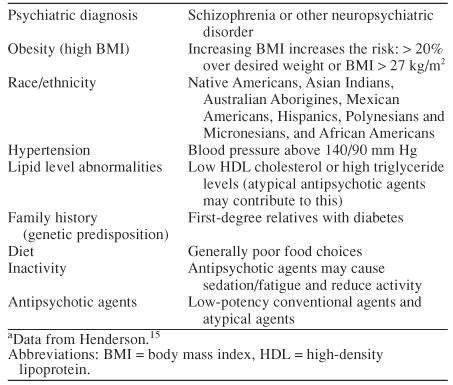
Mukherjee and colleagues18 observed the prevalence of diabetes in 95 residents aged 45 to 74 years in a long-term care facility who met the DSM-III-R criteria for schizophrenia. Inclusion criteria included no history of alcohol or drug use within the last year or endocrine disorders other than diabetes. Subjects were excluded if they had an onset of psychosis after age 40 years, a history of severe head injury preceding psychosis, a history of seizure disorder, any other neurologic disorder, or severe cognitive impairment. Eight of the participants had not been prescribed an antipsychotic treatment for at least 1 year and 87 had been treated continuously for at least 2 years. Diagnosis of diabetes was based on a review of patients' medical records and criteria set forth by the World Health Organization. All patients diagnosed with diabetes had a record of fasting plasma glucose levels greater than 140 mg/dL on at least 2 occasions.
The overall prevalence of diabetes was 15.8%, and a significant difference was not found between age and gender and the prevalence of diabetes. However, untreated patients were reported to have a higher prevalence of diabetes than treated patients.
Although Mukherjee and colleagues studied older adults, other studies19 suggest that type 2 diabetes develops more frequently among younger schizophrenic patients treated with atypical antipsychotics. However, research has yet to determine whether reported cases of early-onset type 2 diabetes are caused by the presence of atypical antipsychotic treatment or merely a quickening of the natural development of the disease in these patients.19
Sernyak et al.19 observed the development of types 1 and 2 diabetes among 38,632 participants treated with atypical and typical antipsychotics. Participants were required to have received either a primary or secondary diagnosis of schizophrenia from at least 2 outpatient visits in a specialty mental health outpatient clinic. For inclusion in the study, participants had to have been prescribed either a conventional antipsychotic or clozapine, risperidone, quetiapine, or olanzapine at least 4 months prior to the study. The typical and atypical antipsychotic groups were further divided into 5 age groups: under 40 years, 40 to 49 years, 50 to 59 years, 60 to 69 years, and over 70 years. Patients treated with atypical antipsychotics had a significantly higher rate of diagnosis of diabetes among the 3 younger age groups during treatment (Figure 3). For example, the under-40 age group had an 8.7% rate of diabetes when prescribed atypicals, compared with a 6.43% rate with typical antipsychotics (p < .07). Also, the risk of being diagnosed with diabetes was greater in all age groups of patients treated with clozapine, olanzapine, and quetiapine than with typical agents or risperidone.
Figure 3.
Percentage of Patients With Schizophrenia Receiving Prescriptions for Atypical and Typical Neuroleptic Medication Who Also Had a Diagnosis of Diabetes Mellitusa
RISKS VERSUS BENEFITS OF ANTIPSYCHOTIC TREATMENT
Despite the risk of potentially serious medical conditions, clinicians need to treat the mental disorder. The treatment of schizophrenia involves the right balance for the patient in terms of adverse effects versus benefit. Failing to treat a patient because of the risk of or complications from diabetes places the patient at a higher risk for more serious problems. Studies15,18 have demonstrated that even untreated patients suffering from schizophrenia are at an increased risk of developing medical conditions associated with metabolic syndrome.
The quality of life associated with schizophrenia ranks among the worst of any chronic medical illness, and treatment with atypical antipsychotics may improve the quality of life for many patients.20 The greatest advantage of atypical antipsychotics is their ability to improve cognition, since impaired cognition is now considered to be a fundamental feature of schizophrenia.20 Atypical antipsychotics have been shown to significantly improve many aspects of cognitive function,21 including executive function, verbal fluency, attention, and memory and learning impairment.22 Atypical antipsychotics have also been shown to be effective in treating depression, as both a monotherapy and an adjunct to antidepressant therapy.23–25
It is arguable that the benefits of antipsychotic treatment outweigh the risks. However, physicians must weigh the risks and benefits for each patient before beginning an antipsychotic treatment. The patient and physician must work together to outline potential risk factors and to carefully monitor risks during treatment.
MONITORING AND MANAGING METABOLIC SYNDROME
When treating an at-risk patient, physicians need to be especially vigilant in monitoring antipsychotic medication. Simple monitoring and management tips can aid physicians in handling potential medical complications (Tables 3 and 4).
Table 3.
Monitoring Tips for Metabolic Syndromea
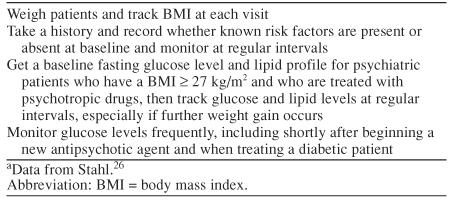
Table 4.
Management Tips for Antipsychotic Treatmenta
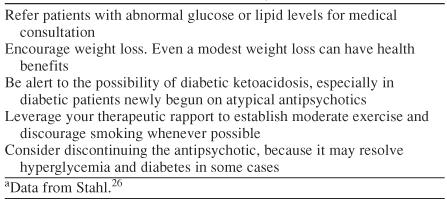
At least 10 million Americans at high risk for type 2 diabetes can sharply lower their chances of getting the disease with diet and exercise.27 With the increased emergence of diabetes and metabolic syndrome, clinicians should consider screening for hyperlipidemia or hyperglycemia annually and prior to starting or changing an antipsychotic treatment.7 Physicians should also consider treatments for lipid dysfunction and weight gain if they emerge during antipsychotic treatment.
Although a dose-response relationship for weight gain has not been established, the development of hyperglycemia after the initiation of or increase in antipsychotic dose could signal a problem. Likewise, physicians who have been worried about metabolic issues with a patient on antipsychotic treatment should increase monitoring when raising the dose.
Weight gain is often the most visible side effect of antipsychotic treatment and therefore can often be the easiest to manage. Physicians should not only weigh patients at regular visits but also pay attention to an increase in weight and be proactive in advising patients. Most patients treated with antipsychotics are at risk to gain 5 lb [2.25 kg] to 7 lb [3.15 kg]. This weight, while perhaps cosmetically undesirable, is much easier to manage and less of a health risk than 30 lb [13.5 kg] or 40 lb [18 kg]. What physicians do not want to see is dramatic weight gain, such as 30 to 40 lb. Weight gain poses serious health risks and can be a distressing issue for the patient. Physicians should educate patients and their families that weight gain is possible and to be on the lookout for it.
Physicians can advise patients to monitor weight by watching how their clothes fit, especially around the waist. Physicians might remind patients to try leaving food on their plate or climbing the stairs instead of taking the elevator. With extremely impaired patients or those who already have substantial weight gain, suggesting a nutritional consultation may help. Steps to treating overweight and obesity in the primary care setting include measuring height and weight, measuring waist circumference, assessing comorbidities, and placing a patient on a diet.
CONCLUSION
While the onset of weight gain, hyperglycemia, increased glucose levels, or diabetes may be signs or symptoms of antipsychotic-induced metabolic syndrome, physicians should nevertheless continue to treat a patient's mental disorder. Careful monitoring of at-risk patients may aid in the prevention of metabolic syndrome as well as the management of any potential symptoms should they occur. With patients suffering from schizophrenia at an already increased risk for diabetes, the advantages and disadvantages of any antipsychotic treatment must be weighed before initiating treatment in a patient.
Drug names: benztropine (Cogentin and others), clozapine (Clozaril and others), haloperidol (Haldol and others), olanzapine (Zyprexa), quetiapine (Seroquel), ranitidine (Zantac and others), risperidone (Risperdal), spironolactone (Aldactone and others).
Footnotes
This article was derived from the planning roundtable “Using Atypical Antipsychotics in Primary Care,” which was held June 2–4, 2002, in Washington, D.C., and supported by an unrestricted educational grant from Janssen Pharmaceutica, L.P.
Disclosure of off-label usage: The author of this article has determined that, to the best of his knowledge, sertindole is not approved for use in the United States.
REFERENCES
- Alberti K, Zimmet P. Definition, diagnosis, and classification of diabetes mellitus and its complications, pt 1: diagnosis and classification of diabetes mellitus provisional report of a WHO consultation. Diabet Med. 1998;15:539–553. doi: 10.1002/(SICI)1096-9136(199807)15:7<539::AID-DIA668>3.0.CO;2-S. [DOI] [PubMed] [Google Scholar]
- Liese A, Mayer-Davis E, Haffner S. Development of the multiple metabolic syndrome: an epidemiologic perspective. Epidemiol Rev. 1998;20:157–172. doi: 10.1093/oxfordjournals.epirev.a017978. [DOI] [PubMed] [Google Scholar]
- American Heart Association. Syndrome X or metabolic syndrome. Available at: http://www.americanheart.org/presenter.jhtml?identifier=534. Accessed July 29, 2003. [Google Scholar]
- Isomaa B, Almgren P, and Tuomi T. et al. Cardiovascular morbidity and mortality associated with the metabolic syndrome. Diabetes Care. 2001 24:683–689. [DOI] [PubMed] [Google Scholar]
- Meduna L, Gerty F, Urse V. Biochemical disturbances in mental disorders. Arch Neurol Psychiatry. 1942;47:38–52. [Google Scholar]
- Raphael T, Parsons I. Blood sugar studies in dementia praecox and manic depressive insanity. Arch Neurol Psychiatry. 1921;5:687–709. [Google Scholar]
- Haupt D, Newcomer J. Hyperglycemia and antipsychotic medications. J Clin Psychiatry. 2001 62suppl 27. 15–26. [PubMed] [Google Scholar]
- Allison DB, Mentore JL, and Heo M. et al. Antipsychotic-induced weight gain: a comprehensive research synthesis. Am J Psychiatry. 1999 156:1686–1696. [DOI] [PubMed] [Google Scholar]
- Must A, Spadano J, and Coakley E. et al. The disease burden associated with overweight and obesity. JAMA. 1999 282:1523–1529. [DOI] [PubMed] [Google Scholar]
- Bustillo JR, Buchanan RW, and Irish D. et al. Differential effect of clozapine on weight: a controlled study. Am J Psychiatry. 1996 153:817–819. [DOI] [PubMed] [Google Scholar]
- Wirshing DA, Wirshing WC, and Kysar L. et al. Novel antipsychotics: comparison of weight gain liabilities. J Clin Psychiatry. 1999 60:358–363. [PubMed] [Google Scholar]
- Ober SK, Hudak R, Rusterholtz A. Hyperglycemia and olanzapine [letter] Am J Psychiatry. 1999;156:970. doi: 10.1176/ajp.156.6.970. [DOI] [PubMed] [Google Scholar]
- Kamran A, Doraiswamy PM, and Jane JL. et al. Severe hyperglycemia associated with high doses of clozapine [letter]. Am J Psychiatry. 1994 151:1395. [DOI] [PubMed] [Google Scholar]
- Newcomer JW, Haupt DW, and Fucetola R. et al. Abnormalities in glucose regulation during antipsychotic treatment of schizophrenia. Arch Gen Psychiatry. 2002 59:337–345. [DOI] [PubMed] [Google Scholar]
- Henderson DC. Atypical antipsychotic–induced diabetes mellitus: how strong is the evidence? CNS Drugs. 2002;16:77–89. doi: 10.2165/00023210-200216020-00001. [DOI] [PubMed] [Google Scholar]
- Kwong K, Cavazzoni P, and Hornbuckle K. et al. Higher incidence of diabetes mellitus during exposure to antipsychotics: findings from a retrospective study in the US [abstract]. Presented at the 41st Annual cohort Meeting of the New Clinical Drug Evaluation Unit. 28–31May2001 Phoenix, Ariz. [Google Scholar]
- Jin H, Meyer JM, Jeste DV. Phenomenology of and risk factors for new-onset diabetes mellitus and diabetic ketoacidosis associated with atypical antipsychotics: an analysis of 45 published cases. Ann Clin Psychiatry. 2002;14:59–64. doi: 10.1023/a:1015228112495. [DOI] [PubMed] [Google Scholar]
- Mukherjee S, Decina P, and Bocola V. et al. Diabetes mellitus in schizophrenic patients. Compr Psychiatry. 1996 37:68–73. [DOI] [PubMed] [Google Scholar]
- Sernyak MJ, Leslie DL, and Alarcon RD. et al. Association of diabetes mellitus with use of atypical neuroleptics in the treatment of schizophrenia. Am J Psychiatry. 2002 159:561–566. [DOI] [PubMed] [Google Scholar]
- Meltzer H. Putting metabolic side effects into perspective: risk versus benefits of atypical antipsychotics. J Clin Psychiatry. 2001 62suppl 27. 35–39. [PubMed] [Google Scholar]
- Keefe RS, Silva SG, and Perkins DO. et al. Effects of atypical antipsychotic drugs on neurocognitive impairment in schizophrenia: a review and meta-analysis. Schizophr Bull. 1999 25:201–222. [DOI] [PubMed] [Google Scholar]
- Collaborative Working Group on Clinical Trial Evaluations. Evaluating the effects of antipsychotics on cognition in schizophrenia. J Clin Psychiatry. 1998 59suppl 12. 35–40. [PubMed] [Google Scholar]
- Ranjan R, Meltzer HY. Acute and long-term effectiveness of clozapine in treatment-resistant psychotic depression. Biol Psychiatry. 1996;40:253–258. doi: 10.1016/0006-3223(95)00305-3. [DOI] [PubMed] [Google Scholar]
- Hillert A, Maier W, and Wetzel H. et al. Risperidone in the treatment of disorders with a combined psychotic and depressive syndrome: a functional approach. Pharmacopsychiatry. 1992 25:213–217. [DOI] [PubMed] [Google Scholar]
- Tollefson GD, Sanger TM, and Beasley CM. et al. Double-blind, controlled comparison of the novel antipsychotic olanzapine versus haloperidol or placebo on anxious and depressive symptoms accompanying schizophrenia. Biol Psychiatry. 1998 43:803–810. [DOI] [PubMed] [Google Scholar]
- Stahl S. The metabolic syndrome: psychopharmacologists should weigh the evidence for weighing the patient [BRAINSTORMS] J Clin Psychiatry. 2002;63:1094–1095. doi: 10.4088/jcp.v63n1201. [DOI] [PubMed] [Google Scholar]
- National Institute of Diabetes & Digestive & Kidney Disease. Diet and exercise dramatically delay type 2 diabetes: diabetes medication metformin also effective. Available at: http://www.niddk.nih.gov/welcome/releases/8_8_01.htm Accessed Aug 20, 2003. [Google Scholar]



